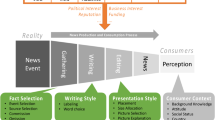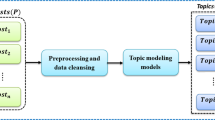Abstract
Event detection is a fundamental information extraction task, which has been explored largely in the context of question answering, topic detection and tracking, knowledge base population, news recommendation, and automatic summarization. In this article, we explore an event detection framework to improve a key phrase-guided centrality-based summarization model. Event detection is based on the fuzzy fingerprint method, which is able to detect all types of events in the ACE 2005 Multilingual Corpus. Our base summarization approach is a two-stage method that starts by extracting a collection of key phrases that will be used to help the centrality-as-relevance retrieval model. We explored three different ways to integrate event information, achieving state-of-the-art results in text and speech corpora: (1) filtering of nonevents, (2) event fingerprints as features, and (3) combination of filtering of nonevents and event fingerprints as features.




Similar content being viewed by others
References
Abbasi A, Chen H (2008) Writeprints: a stylometric approach to identity-level identification and similarity detection in cyberspace. ACM Trans. Inf. Syst. 26(2):7:1–7:29
Allan J, Carbonell J, Doddington G, Yamron J, Yang Y, Archibald B, Scudder M (1998) Topic detection and tracking pilot study final report. In: Proceedings of the broadcast news transcription and understanding workshop
Bollacker K, Evans C, Paritosh P, Sturge T, Taylor J (2008) Freebase: a collaboratively created graph database for structuring human knowledge. In: Proceedings of the 2008 ACM SIGMOD international conference on management of data, SIGMOD ’08. ACM, New York pp 1247–1250
Carbonell J, Goldstein J (1998) The use of MMR, diversity-based reranking for reordering documents and producing summaries. In: SIGIR ’98: proceedings of the 21st annual international ACM SIGIR conference on research and development in information retrieval. ACM, New York, pp 335–336
Carbonell J, Yang Y, Lafferty J, Brown RD, Pierce T, Liu X (1998) CMU approach to TDT: segmentation, detection, and tracking. In: Proceedings of the DARPA broadcast news conference
Chakrabarti D, Punera K (2011) Event summarization using tweets. In: Proceedings of the 5th international conference on weblogs and social media (ICWSM)
Daniel N, Radev D, Allison T (2003) Sub-event based multi-document summarization. In: Proceedings of the HLT-NAACL 03 on text summarization workshop-Vol 5, HLT-NAACL-DUC ’03. Association for Computational Linguistics, Stroudsburg, pp 9–16
Duan Y, Chen Z, Wei F, Zhou M, Shum H (2012) Twitter topic summarization by ranking tweets using social influence and content quality, In: COLING 2012, 24th international conference on computational linguistics, proceedings of the conference: technical papers, 8–15 December 2012, pp 763–780
Erkan G, Radev DR (2004) LexRank: graph-based centrality as salience in text summarization. J Artif Intell Res 22:457–479
Feng A, Allan J (2007) Finding and linking incidents in news. In: CIKM ’07: proceedings of the 16th ACM conference on information and knowledge management. ACM, New York, pp 821–830
Filatova E, Hatzivassiloglou V (2004) Event-based extractive summarization. In: Proceedings of ACL workshop on summarization, pp 104–111
Glavaš G, Šnajder J (2014) Event graphs for information retrieval and multi-document summarization. Expert Syst Appl 41(15):6904–6916
Homem N, Carvalho JP (2011) Authorship identification and author fuzzy “fingerprints”. In: Proceedings of 2011 annual meeting of the North American fuzzy information processing society (NAFIPS). IEEE pp 1–6
Hong Y, Zhang J, Ma B, Yao J, Zhou G, Zhu Q (2011) Using cross-entity inference to improve event extraction. In: Proceedings of the 49th annual meeting of the association for computational linguistics: human language technologies—vol 1, HLT ’11. Association for Computational Linguistics, Stroudsburg, pp 1127–1136
Huang X, Wan X, Xiao J (2014) Comparative news summarization using concept-based optimization. Knowl Inf Syst 38(3):691–716
Ji H, Grishman R (2011) Knowledge base population: successful approaches and challenges. In: Proceedings of the 49th annual meeting of the association for computational linguistics: human language technologies—vol 1’, HLT ’11. Association for Computational Linguistics, Stroudsburg, pp 1148–1158
Li W, Wu M, Lu Q, Xu W, Yuan C (2006) Extractive summarization using inter- and intra-event relevance. In: ACL 2006, 21st international conference on computational linguistics and 44th annual meeting of the association for computational linguistics, proceedings of the conference, Sydney, Australia, 17–21 July 2006. Association for Computational Linguistics, Stroudsburg, pp 369–376
Liao S, Grishman R (2010) Using document level cross-event inference to improve event extraction. In: Proceedings of the 48th annual meeting of the association for computational linguistics, ACL ’10. Association for Computational Linguistics, Stroudsburg, pp 789–797
Lin C-Y (2004) ROUGE: a package for automatic evaluation of summaries. In: Text summarization branches out: proceedings of the ACL-04 workshop. Association for Computational Linguistics, pp 74–81
Litvak M, Last M (2008) Graph-based keyword extraction for single-document summarization. In: Proceedings of the workshop on MMIES’, MMIES ’08. Association for Computational Linguistics, Stroudsburg pp 17–24
Liu M, Li W, Wu M, Lu Q (2007) Extractive summarization based on event term clustering. In: Proceedings of the 45th annual meeting of the ACL on interactive poster and demonstration sessions’, ACL ’07. Association for Computational Linguistics, Stroudsburg, pp 185–188
Marujo L, Carvalho JP, Gershman A, Carbonell J, Neto JP, de Matos DM (2015) Textual event detection using fuzzy fingerprints. In: Angelov P, Atanassov K, Doukovska L, Hadjiski M, Jotsov V, Kacprzyk J, Kasabov N, Sotirov S, Szmidt E, Zadrożny S (eds) Intelligent systems’ 2014, vol 322 of advances in intelligent systems and computing. Springer, Berlin, pp 825–836
Marujo L, Gershman A, Carbonell J, Frederking R, Neto JP (2012) Supervised topical key phrase extraction of news stories using crowdsourcing, light filtering and co-reference normalization. In: Proceedings of the 8th language resources and evaluation conference (LREC 2012), ELRA
Marujo L, Portelo J, Martins de Matos D, Neto JP, Gershman A, Carbonell J, Trancoso I, Raj B (2014) Privacy-preserving important passage retrieval. In: Proceedings of the 1st international workshop on privacy-preserving IR: when information retrieval meets privacy and security co-located with 37th annual international ACM SIGIR conference (SIGIR 2014). CEUR, pp 7–12
Marujo L, Viveiros M, Neto JP (2011) Keyphrase cloud generation of broadcast news. In: Proceeding of interspeech 2011: 12th annual conference of the international speech communication association, ISCA
Maskey SR (2008) Automatic broadcast news speech summarization. Ph.D. thesis, Columbia University
Maskey SR, Hirschberg J (2005) Comparing lexical, acoustic/prosodic, structural and discourse features for speech summarization. In: Proceedings of the 9th EUROSPEECH—INTERSPEECH 2005
Mei J-P, Chen L (2012) Sumcr: a new subtopic-based extractive approach for text summarization. Knowl Inf Syst 31(3):527–545
Nallapati R, Feng A, Peng F, Allan J (2004) Event threading within news topics. In: CIKM ’04: Proceedings of the 13th ACM international conference on information and knowledge management. ACM, New York, pp 446–453
Naughton M, Stokes N, Carthy J (2008) Investigating statistical techniques for sentence-level event classification. In: Proceedings of the 22nd international conference on computational linguistics—vol 1, COLING ’08. Association for Computational Linguistics, Stroudsburg, pp 617–624
Nichols J, Mahmud J, Drews C (2012) Summarizing sporting events using twitter. In: Proceedings of the 2012 ACM international conference on intelligent user interfaces, IUI ’12. ACM, New York, pp 189–198
Olariu A (2014) Efficient online summarization of microblogging streams. In: Proceedings of the 14th conference of the European chapter of the association for computational linguistics, vol 2: short papers. Association for Computational Linguistics, Gothenburg, pp 236–240
Ribeiro R, de Matos DM (2011) Revisiting centrality-as-relevance: support sets and similarity as geometric proximity. J Artif Intell Res 42:275–308
Ribeiro R, Marujo L, Martins de Matos D, Neto JP, Gershman A, Carbonell J (2013) Self reinforcement for important passage retrieval. In: SIGIR ’13: proceedings of the 36th international ACM SIGIR conference on research and development in information retrieval. ACM, New York, pp 845–848
Riedhammer K, Favre B, Hakkani-Tür D (2010) Long story short—global unsupervised models for keyphrase based meeting summarization. Speech Commun 52:801–815
Rosa H, Batista F, Carvalho JP (2014) Twitter topic fuzzy fingerprints. In: 2014 IEEE international conference on fuzzy systems (FUZZ-IEEE). IEEE, pp 776–783
Rubin TN, Chambers A, Smyth P, Steyvers M (2012) Statistical topic models for multi-label document classification. Mach Learn 88(1–2):157–208
Saggion H, Szasz S (2012) The CONCISUS corpus of event summaries. In: Proceedings of the 8th language resources and evaluation conference (LREC 2012), ELRA
Sharifi B, Hutton M-A, Kalita J (2010) Summarizing microblogs automatically. In: Human language technologies: the 2010 annual conference of the North American chapter of the association for computational linguistics, HLT ’10. Association for Computational Linguistics, Stroudsburg, pp 685–688
Shou L, Wang Z, Chen K, Chen G (2013) Sumblr: continuous summarization of evolving tweet streams. In: Proceedings of the 36th international ACM SIGIR conference on research and development in information retrieval, SIGIR ’13. ACM, New York, pp 533–542
Sipos R, Swaminathan A, Shivaswamy P, Joachims T (2012) Temporal corpus summarization using submodular word coverage. In: CIKM ’12: proceedings of the 21st ACM international conference on information and knowledge management. ACM, New York, pp 754–763
Takamura H, Yokono H, Okumura M (2011) Summarizing a document stream. In: Proceedings of the 33rd European conference on advances in information retrieval, ECIR’11. Springer, Berlin, pp 177–188
Tucker RI, Spärck Jones K (2005) Between shallow and deep: an experiment in automatic summarising. Technical report 632, University of Cambridge
Uysal I, Croft WB (2011) User oriented tweet ranking: a filtering approach to microblogs. In: Proceedings of the 20th ACM international conference on information and knowledge management, CIKM ’11. ACM, New York, pp 2261–2264
Uzêda V, Pardo T, Nunes M (2010) A comprehensive comparative evaluation of RST-based summarization methods. ACM Trans Speech Lang Process (TSLP) 6(4):1–20
Vanderwende L, Suzuki H, Brockett C, Nenkova A (2007) Beyond SumBasic: task-focused summarization and lexical expansion. Inf Process Manag 43:1606–1618
Walker C, Strassel S, Medero J (2006) ACE 2005 multilingual training corpus. Linguistic Data Consortium, Philadelphia
Wan X, Yang J, Xiao J (2007) Towards an iterative reinforcement approach for simultaneous document summarization and keyword extraction. In: Proceedings of the 45th annual meeting of the association for computational linguistics (ACL 2007). Association for Computational Linguistics Prague, pp 552–559
Yang Y, Carbonell JG, Brown RD, Pierce T, Archibald BT, Liu X (1999) Learning approaches for detecting and tracking news events. IEEE Intell Syst 14(4):32–43
Yang Y, Liu X (1999) A re-examination of text categorization methods. In: SIGIR’ 99: proceedings of the 22nd annual international ACM SIGIR conference on research and development in information retrieval. ACM, New York, pp 42–49
Yang Y, Pierce T, Carbonell J (1998) A study of retrospective and on-line event detection. In: SIGIR ’98: proceedings of the 21st annual international ACM SIGIR conference on research and development in information retrieval. ACM, New York, pp 28–36
Zechner K, Waibel A (2000) Minimizing word error rate in textual summaries of spoken language. In: Proceedings of the 1st North American chapter of the association for computational linguistics conference, Morgan Kaufmann, pp 186–193
Zha H (2002) Generic summarization and keyphrase extraction using mutual reinforcement principle and sentence clustering. In: SIGIR ’02: proceedings of the 25th annual international ACM SIGIR conference on research and development in information retrieval. ACM, New York pp 113–120
Acknowledgments
We thank anonymous reviewers for their very useful comments and suggestions. This work was supported by national funds through FCT under Project UID/CEC/50021/2013, the Carnegie Mellon Portugal Program, and Grant SFRH/BD/33769/2009.
Author information
Authors and Affiliations
Corresponding author
Rights and permissions
About this article
Cite this article
Marujo, L., Ribeiro, R., Gershman, A. et al. Event-based summarization using a centrality-as-relevance model. Knowl Inf Syst 50, 945–968 (2017). https://doi.org/10.1007/s10115-016-0966-4
Received:
Revised:
Accepted:
Published:
Issue Date:
DOI: https://doi.org/10.1007/s10115-016-0966-4




